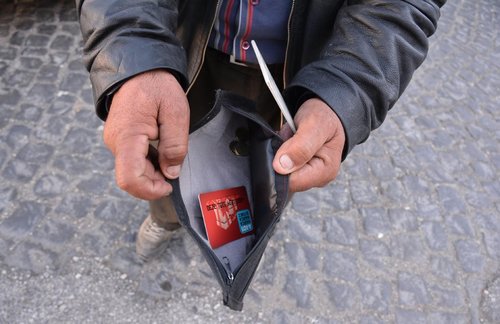The share of Turkey’s richest 20 percent in the total income generated in the country in 2021 was 46.7 percent, according to the Turkish Statistical Institute’s (TurkStat) Income and Living Conditions Survey.
The share of the richest quintile decreased by 0.8 percent and the share of the bottom quintile rose by 0.2 points to 6.1 percent.
The S80/S20 ratio, the ratio of the total income the richest 20 percent to the poorest 20 percent, decreased from 8.0 to 7.6 percent and the S90/S10 ratio, which is the ratio of total income received by the richest 10 percent of the population to that received by the poorest 10 percent of the population decreased from 14.6 to 13.7.
CLICK – Inflation rate higher for the poor
Household disposable income
The mean annual household disposable income was 76,733 Turkish lira in 2021, with an increase of 10.6 percent compared to the previous year. (1 USD = 14.98 Turkish lira)
The mean annual equivalised household disposable income rose by 11.9 percent compared to the previous year, from 33,428 lira to 37,400 lira.
According to the household type, the highest mean annual equivalised household disposable income was observed among the one-person households with 49,297 lira with an increase of 6,585 lira compared to previous year.
The mean annual equivalised household disposable income of the multi-person no-family households was 41,753 lira while this income of the one-family households was 38,159 lira. The household type with the lowest mean annual equivalised disposable income was extended-family households with 29,445 lira.
Wages and salaries
The ratio of wage and salaries got the highest rate, with 47.1 percent of total equivalised household disposable income without change compared with the previous year.
This was followed by social transfers with 23.9 percent with an increase of 2.1 points and entrepreneurial incomes 17.5 percent with a decrease compared to 2020.
Education levels
Higher education graduates had the highest mean annual income at main job with 68,229 lira
Mean annual income at the main job was calculated as 68,229 lira for higher education graduates, 47,326 lira for high or equivalent school graduates, 35,344 lira for those with less than high school education 25,911 lira for those who do not graduate from a school and 19,835 lira for illiterate individuals. In 2021, compared to 2020, the highest increase in income at main job was observed in the illiterate individuals with 18.2 percent and the lowest increase was in the less than high school graduates with 7.6 percent.
Sectors
The highest mean annual income was in the service sector with 51,173 lira and the lowest mean annual income was in the agricultural sector with 32,635 lira. Compared to the previous year; the highest increase in mean annual income was observed in the agriculture sector with 29.2 percent, followed by the service sector with 11.2 percent. On the other hand, an increase of 6.1 percent was observed in the industrial sector and 4.7 percent in the construction sector.
Employers
Mean annual income at the main job was 136,280 lira for employers, 46,846 lira for regular employees, 37,871 lira for self-employed workers and 18,006 lira for casual employees. Compared to the previous year, the highest increase was in self employed with 14.0 percent and the lowest increase was in casual employed workers with 2.4 percent.
Relative poverty rate
The people having incomes below a specified line compared to the general population are defined to be the poor in a relative sense. The at-risk-of-poverty-rate according to the poverty threshold set at 50 percent of median equivalised household disposable income was 14.4 percent with a decrease of 0.6 points compared to 2020.
As for the at-risk-of-poverty-rate according to the poverty threshold set at 60 percent of median equivalised household disposable income, it was 21.3 percent with a decrease of 0.6 points in comparison with the previous year.
The at-risk-of-poverty-rate according to the poverty threshold set at 40 percent of median equivalised household disposable income was 8.5 percent with a decrease of 0.4 points compared to the previous year and poverty threshold set at 70 percent of median equivalised household disposable income was 28.7 percent with a decrease of 0.3 points.
One-person households
Considering poverty rates according to poverty threshold set at 50 percent of median equivalised household disposable income in terms of household types, at-risk-of-poverty-rate of one-person households was 6.5 percent with a decrease of 4.4 points, multi-person no-family households was 9.1 percent with a decrease of 0.4 points, extended family households was 18.5 percent with a decrease of 0.1 points and one-family households was 14.2 percent with a decrease of 0.3 points compared to the previous year.
Illiterates and higher education graduates
In terms of the at-risk-of-poverty-rate according to the poverty threshold set at 50 percent of median equivalised household disposable income, 24.1 percent of illiterates and 24.4 percent of literates with no degree were poor. The figures for less than high school and high school graduates were 13.8 percent and 7.5 percent, respectively. Higher education graduates were the group with the lowest poverty rate with 2.5 percent.
Severe material deprivation rate
Material deprivation reflects to perception of households about inability to pay unexpected financial expenses, one week’s annual holiday away from home, mortgage or rent payments, a meal with meat, chicken, fish every second day and heating home adequately warm and the ownership of a washing machine, a color TV, a telephone and a car.
The severe material deprivation rate defined as the rate of people faced with the enforced inability to afford at least four of the above-mentioned items decreased from 27.4 percent in 2020 to 27.2 percent in 2021.
Material deprivation rate and point changes compared to the previous year, 2017-2021. (VK)
Source:Bianet
***Show us some LOVE by sharing it!***



